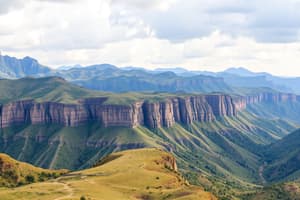Podcast
Questions and Answers
Beaches are examples of tectonic landforms.
Beaches are examples of tectonic landforms.
False (B)
Cliffs are examples of erosional landforms.
Cliffs are examples of erosional landforms.
True (A)
Himalayan mountain range is an example of an erosional landform.
Himalayan mountain range is an example of an erosional landform.
False (B)
Dunes are typically formed by the accumulations of sediment deposited by wind.
Dunes are typically formed by the accumulations of sediment deposited by wind.
Valleys are examples of tectonic landforms.
Valleys are examples of tectonic landforms.
Flashcards are hidden until you start studying
Study Notes
Landforms: Shaping Our Planet
Landforms are natural or anthropogenic features on the solid surface of the Earth or other planetary bodies. They include various types of geological structures, such as mountains, hills, valleys, and plateaus, as well as shoreline features like bays and peninsulas. The arrangement of landforms in a landscape is known as topography. In this article, we will explore the factors that shape landforms, the processes that create them, and the categories of landforms that exist.
Factors and Forces in Landform Formation
Landforms are formed by a combination of geological, climatic, and gravitational forces. The most prominent of these forces are waves, tides, and currents, which interact with the ocean bottom and cause sediment to become temporarily suspended and available for movement by coastal currents. The larger the wave, the deeper the water in which this process takes place and the larger the particle that can be moved.
Landform Classification
Landforms can be categorized based on their physical attributes, such as elevation, slope, orientation, structure, stratification, rock exposure, and soil type. Gross physical features or landforms include mountains, hills, plateaus, and plains. Minor landforms include buttes, canyons, valleys, and basins.
Depositional Landforms
Depositional landforms are produced from the deposition of weathered and eroded surface materials. Examples of depositional landforms include beaches, barrier islands, spits, deltas, flood plains, dunes, alluvial fans, and glacial moraines. These features are typically formed by the accumulation of sediment deposited by water, wind, or glacial movement.
Erosional Landforms
Erosional landforms are created by the removal of surface materials, such as soil, rock, or sediment. Examples of erosional landforms include cliffs, canyons, and valleys. These features are typically formed by the erosive action of water, wind, or glaciers.
Tectonic Landforms
Tectonic landforms are created by the movement of tectonic plates, which can push up mountains and hills or create volcanoes. Examples of tectonic landforms include the Himalayan mountain range and the Hawaiian Islands.
Landform Development and Change
Landforms are dynamic features that are continually affected by a variety of earth-surface processes, including weathering, erosion, and deposition. Earth scientists who study landforms provide decision-makers with information to make natural resource, cultural management, and infrastructure decisions that affect humans and the environment.
In conclusion, landforms are diverse features that shape our planet's landscape. They are formed by a combination of geological, climatic, and gravitational forces, and can be classified into depositional, erosional, and tectonic categories. Landforms are dynamic features that are continually changing and evolving, and their study is essential for understanding our planet's geological processes and for making informed decisions about how to manage our natural resources.
Studying That Suits You
Use AI to generate personalized quizzes and flashcards to suit your learning preferences.




